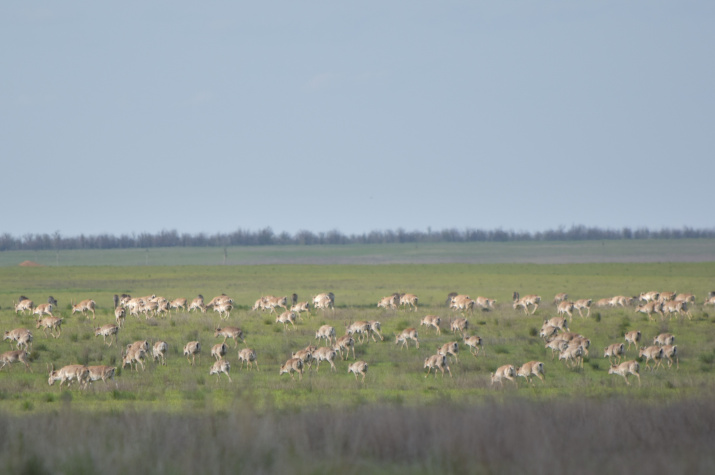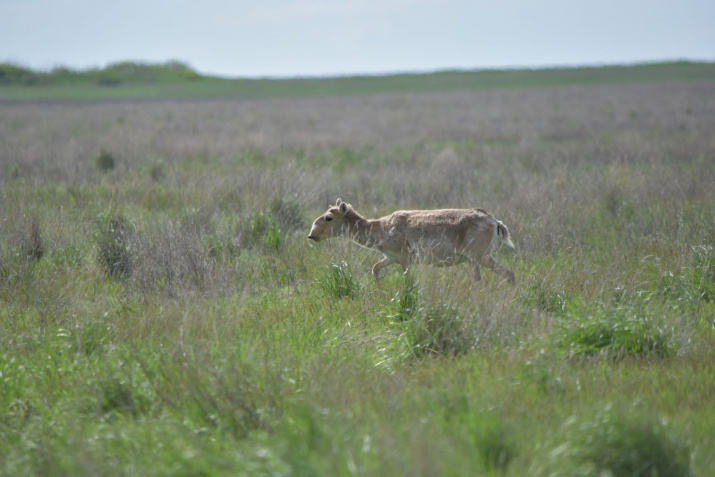At the end of April, the participants of the RGS Steppe Expedition witnessed the mass migration of saigas across the Russian-Kazakh border. Several tens of thousands of Red Book animals appeared at once in Pitersky District of Saratov Oblast.
“On April 26, there was a massive saiga arrival from Kazakhstan,” said the head of the expedition team, professor at the Russian Academy of Sciences Sergey Levykin. “The Red Book, strategic species came to the Saratov steppes for the calving, which began on April 28. A large space is literally littered with newly born saiga calves. At the same time, mixed herds of males and females move in scattered groups in a large space around newborns.”
The saiga is a steppe antelope, the only one of the key species of wild ungulates that still retains its ecosystem significance in the steppes west of the Ural River. In 2020, the saiga was included in the Red Book of the Russian Federation, and then entered the list of priority species of the federal project "Conservation of Biological Diversity and Development of Ecological Tourism" (national project "Ecology"). In 2021, the expedition project "Across the Transvolga Region with Saigas" was supported by the Russian Geographical Society and is being implemented as part of the RGS Steppe Expedition.
The massive arrival of saigas in Saratov Oblast has been observed for the last two years, but now the number of "migrants" exceeds the previous scale. The scientists believe that this is a natural process.
The saiga population living between the Volga and Ural Rivers, as well as the species as a whole, experienced a catastrophic decline in numbers and range at the turn of the 20th and 21st centuries. One of the reasons was mass poaching. The animals were shot for horns, for which there is a high demand in China. The second significant reason, apparently, was the profound changes in pastoral cattle breeding that occurred in the 1990s. Often the situation was aggravated by epidemics of animal diseases.
As a result, saigas almost ceased to appear in the Russian steppe Transvolga region, remaining on the territory of Kazakhstan, where their migration routes and places of seasonal concentrations were located.
As the population has recovered in the last ten years, steppe antelopes have been entering the Russian territory more and more often and in increasing numbers in the border areas of Astrakhan, Volgograd and Saratov Oblasts. The most massive arrival in recent years occurred in 2020. At the population peak there were about 40-50 thousand saigas on the territory of Russia. It is possible that a new record will be set this year.
Meanwhile, the restoration of the number of these rare animals has a flip side.
“Unfortunately, the massive arrival of the saiga caused conflict with the interests of local farmers. They are sounding the alarm about the future harvest, which can be completely destroyed by herds of saigas, as happened in 2021 in Novouzensky District,” said Sergey Levykin.
The herds of saigas, several thousand strong, unintentionally trample fields, eat green shoots of winter crops, "occupy" watering holes. Farmers drive off the steppe antelopes, which frequently leads to the frightened animals dying in a stampede, and most often newborn saigas become the victims.
The desire to minimize the conflicts between the saigas and humans was the reason for the creation of a special team of scientists within the traditional Steppe Expedition of the Russian Geographical Society. The aim is to study the ecological and geographical aspects of spring migrations of saigas in the Volga-Ural interfluve. The researchers at the Institute of Steppe of the Ural Branch of the Russian Academy of Sciences are ready to help with the organization of corridors that would prevent animals from entering farmlands. One of the solutions to the problem may be the creation of seasonal sanctuaries for the protection of saigas on migration routes and breeding grounds in the Russian-Kazakh border area.



